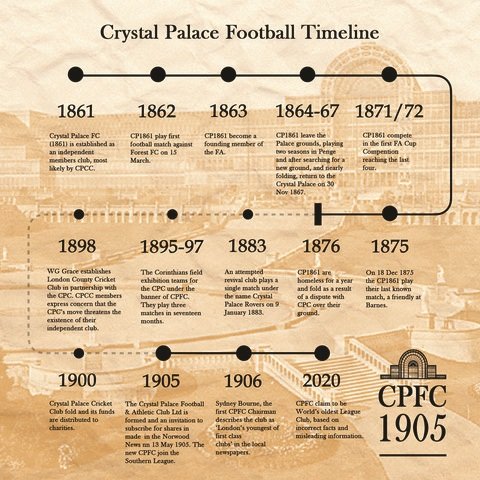South London Memories: ‘Crystal Palace’…the oldest professional football club in the world?
Crystal Palace’s claim to be the oldest professional football club in the world has been disputed by some football historians.
This month, the club published new research documenting how the club has roots going back to 1861, despite the fact its foundation date has until recently been listed as 1905.
That would see the Eagles overtake Notts County FC – founded in 1862 – for the prestigious title.
But 19th century football experts Mark Metcalf and Clive Nicholson have produced an 84-page document of research to dispute Palace’s Victorian credentials. It has been submitted to the FA and EFL for adjudication.
They dispute the links between the Crystal Palace founded 115 years ago and the works team of the Crystal Palace Company, which was set up in 1852 in the wake of the Great Exhibition.
Metcalf and Nicholson said in a joint statement: “This is quite a claim. Our examination was very thorough and has resulted in an 84-page document packed with primary and contemporary source materials.
“This document shows the Crystal Palace Football Club claim is slightly absurd and is ultimately reduced to a short note in 1906 in the CPFC club handbook and which appears never to have been mentioned again anywhere by CPFC until very recently.

“It is possible to forget your own history but that really is a serious memory lapse.”
Metcalf, who wrote The Origins of the Football League, and Nicholson, author of a biography of Sheffield Wednesday legend Fred Spiksley, claim the first CPFC side were affiliated to the FA from 1861-75, at which point the club closed.
There is then no FA affiliated club for a 30 year period until a new and totally separate club formed in 1905.
They claim:
- the official CPFC supporters’ magazine from October 1947 states “to prevent misunderstanding, it should be pointed out that the Crystal Palace Club in existence before 1905 was a purely amateur concern and had no connection with the present club.”
- three games in the mid-1890s under the banner of CPFC all contained eight or nine players from Corinthian FC.
- It was CPFC in name only – and only a football spectacle to entertain the crowds at the Crystal Palace.
- reports in 1895 and 1905 said any club set up would be a new one with no mention about any connection to the 1861-1875 CPFC.
- local and national press reports of a new CPFC in the mid-1890s always reported it would be a new club.
Claims by CPFC today that the failure at this time was due to the proposed club being barred from playing on the cricket pitch at The Crystal Palace are “shown to be wrong”. - all articles in the year leading up to and including September 1905 specifically mention this is a new club.
The earlier claim comes up just once in a club handbook in 1906 and was then hidden for more than a century. - CPFC’s claims are “largely hypotheses of unproven facts such as the claim that as other professional clubs were set up out of cricket clubs then so must CPFC in 1905.”
Author Peter Manning had researched Palace’s distant history to make the claim for the Selhurst Park club.
He argued the Crystal Palace Company had sports clubs, with cricket in the summer – starting in 1861 and football in the winter – established in 1861 and playing a first game against Forest FC on March 15, 1862. They had representation at the Football Association’s inaugural meeting in 1863.
The amateur club carried on until 1900, when it merged with WG Grace’s London County Cricket Club.
The professional football club came into being in 1905 – and the Crystal Palace Company bought 1,700 shares for a controlling interest.
A statement on the Palace website said: “When the professional club published its first handbook in 1906, having joined Division Two of the Southern League, it listed some of the internationals who had previously represented the club, including Alex Morten in 1873 and Arthur Savage and Charles Eastlake Smith in 1876, showing that they recognised
themselves as a continuation of the original amateur team.”
